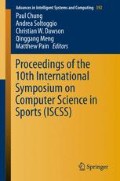Abstract
A soccer player’s ability to make an “effective” pass in a play situation is considered one of the key skills characterizing successful performance in elite soccer.
Access this chapter
Tax calculation will be finalised at checkout
Purchases are for personal use only
Preview
Unable to display preview. Download preview PDF.
References
Bush, M., Barnes, C., Archer, D. T., Hogg, B., & Bradley, P. S. (2015). Evolution of match performance parameters for various playing positions in the English Premier League. Human Movement Science, 39, 1-11. doi: 10.1016/j.humov.2014.10.003
Ensum, J., Pollard, R., & Taylor, S. (2004). Applications of logistic regression to shots at goal in association football: calculation of shot probabilities, quantification of factors and player/team. Journal of Sports Sciences, 22(6), [np].
Fonseca, S., Milho, J., Travassos, B., & Araujo, D. (2012). Spatial dynamics of team sports exposed by Voronoi diagrams. Human Movement Science, 31(6), 1652-1659. doi:10.1016/j.humov.2012.04.006
Gudmundsson, Joachim, & Wolle, Thomas. (2014). Football analysis using spatiotemporal tools. Computers, Environment and Urban Systems, 47(0), 16-27. doi: http://dx.doi.org/10.1016/j.compenvurbsys.2013.09.004
Hughes, M., & Franks, I. (2005). Analysis of passing sequences, shots and goals in soccer. Journal of Sports Sciences, 23(5), 509-514. doi: 10.1080/02640410410001716779
Kim, S. (2004). Vornoi analysis of a soccer game. Nonlinear Analysis: Modelling and Control, 9(3), 233-240.
Lago-Penas, Carlos, Lago-Ballesteros, Joaquin, Dellal, Alexandre, & Gomez, Maite. (2010). Game-Related Statistics that Discriminated Winning, Drawing and Losing Teams from the Spanish Soccer League. Journal of Sports Science and Medicine 9, 288-293.
Liu, H., Gomez, M. A., Lago-Penas, C., & Sampaio, J. (2015). Match statistics related to winning in the group stage of 2014 Brazil FIFA World Cup. Journal of Sports Science, 33(12), 1205-1213. doi: 10.1080/02640414.2015.1022578
Luhtanen, Pekka, Belinskij, Antti, Hayrinen, Mikko, & Vanttinen, Tomi. (2001). A comparative tournament analysis between the EURO 1996 and 2000 in soccer. International Journal of Performance Analysis in Sport, 1(1), 74-82.
Mackenzie, R., & Cushion, C. (2013). Performance analysis in football: a critical review and implications for future research. Journal of Sports Science, 31(6), 639-676. doi:10.1080/02640414.2012.746720
Nakanishi, Ryota, Murakami, Kazuhito, & Naruse, Tadashi. (2008). Dynamic Positioning Method Based on Dominant Region Diagram to Realize Successful Cooperative Play. In U. Visser, F. Ribeiro, T. Ohashi & F. Dellaert (Eds.), RoboCup 2007: Robot Soccer World Cup XI (Vol. 5001, pp. 488-495): Springer Berlin Heidelberg.
Pollard, R., Ensum, J., & Taylor, Samuel. (2004). Estimating the probability of a shot resulting in a goal: The effects of distance, angle and space. International Journal of Soccer and Science, 2(1), 50-55.
Taki, T., & Hasegawa, J. (2000, 2000). Visualization of dominant region in team games and its application to teamwork analysis. Paper presented at the Computer Graphics International, 2000. Proceedings.
Tenga, A., Ronglan, Lars T., & Bahr, Roald. (2010). Measuring the effectiveness of offensive match-play in professional soccer. European Journal of Sport Science, 10(4), 269-277. doi: 10.1080/17461390903515170
Wallace, J. L., & Norton, K. I. (2014). Evolution of World Cup soccer final games 1966-2010: game structure, speed and play patterns. J Sci Med Sport, 17(2), 223-228. doi:10.1016/j.jsams.2013.03.016
Yiannakos, A., & Armatas, V. (2006). Evaluation of the goal scoring patterns in European Championship in Portugal 2004. International Journal of Performance Analysis in Sport, 6(1), 178-188.
Author information
Authors and Affiliations
Editor information
Editors and Affiliations
Rights and permissions
Copyright information
© 2016 Springer International Publishing Switzerland
About this paper
Cite this paper
Rein, R., Raabe, D., Perl, J., Memmert, D. (2016). Evaluation of changes in space control due to passing behavior in elite soccer using Voronoi-cells. In: Chung, P., Soltoggio, A., Dawson, C., Meng, Q., Pain, M. (eds) Proceedings of the 10th International Symposium on Computer Science in Sports (ISCSS). Advances in Intelligent Systems and Computing, vol 392. Springer, Cham. https://doi.org/10.1007/978-3-319-24560-7_23
Download citation
DOI: https://doi.org/10.1007/978-3-319-24560-7_23
Published:
Publisher Name: Springer, Cham
Print ISBN: 978-3-319-24558-4
Online ISBN: 978-3-319-24560-7
eBook Packages: Computer ScienceComputer Science (R0)

